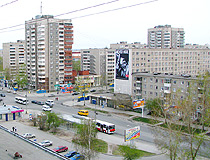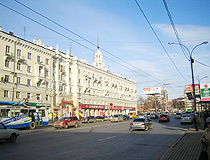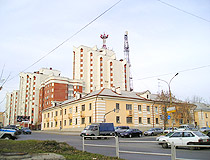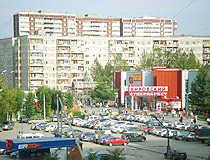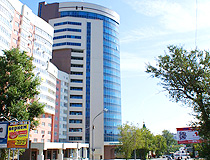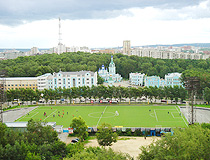Сочинение на тему «Екатеринбург»на английском языке с переводом на русский язык |
|
Ekaterinburg |
Екатеринбург |
|
Ekaterinburg is the fourth largest city in Russia (after Moscow, Saint Petersburg, and Novosibirsk). This megacity with the population over a million people is rapidly developing: it is an administrative, industry, trading, and cultural center of the Ural region. Often Ekaterinburg is called “the Ural capital” or “the gates to Asia”, because it connects Asiatic Russia, Siberia with central regions. Due to numerous financial and trading operations, quality infrastructure, Ekaterinburg is a modern postindustrial business center. Many transnational corporations have their branches there, so high status of Ekaterinburg is confirmed all over the world. |
Екатеринбург – четвёртый по величине город России (после Москвы, Санкт-Петербурга и Новосибирска). Этот мегаполис с населением более миллиона человек быстро развивается: он является административным, промышленным, торговым и культурным центром Урала. Часто Екатеринбург называют «уральской столицей» или «воротами в Азию», так как он соединяет азиатскую Россию, Сибирь с центральными регионами. Благодаря многочисленным финансовым и торговым операциям, качественной инфраструктуре, Екатеринбург представляет собой современный постиндустриальный бизнес-центр. Многие транснациональные корпорации имеют там свои филиалы, поэтому высокий статус Екатеринбурга признан во всём мире. |
|
The city was founded by the order of Peter I in 1723 as the main settlement in the Urals where the network of metallurgical plants was increasing. It was named in honor of Peter’s wife, the empress Ekaterina I. Iron, minerals and even gold mining helped the city to grow and prosper. Besides, it was an important transport junction: the Siberian trading tract passed through it, as well as the Transsiberian railway later. At the end of the 19th century, the city became one of the revolutionary movement hotbeds. As a part of the USSR, it had the name Sverdlovsk and was constantly improving: several universities, a machine building plant, the international airport appeared there. |
Город был основан по указу Петра I в 1723 г. как главное поселение на Урале, где росла сеть металлургических заводов. Он был назван в честь жены Петра, императрицы Екатерины I. Добыча железа, минералов и даже золота помогала городу увеличиваться и процветать. Кроме того, он был важным транспортным узлом: Сибирский торговый тракт проходил через него, как и Транссибирская магистраль позднее. В конце XIX века город стал одним из очагов революционного движения. В составе СССР он носил имя Свердловск и стабильно развивался: появились несколько университетов, машиностроительный завод, международный аэропорт. |
|
Nowadays, various landmarks make Ekaterinburg attractive for tourists and its own citizens. Palaces and manors built in classic style coexist with hi-tech business centers and skyscrapers. There are some picturesque parks, a zoo, and botanical garden. Museums are dedicated to the mining industry, minerals and gems, local folk crafts, and famous people (for example, to the Ural writer Bazhov). |
В наши дни различные достопримечательности делают Екатеринбург привлекательным для туристов и местных жителей. Дворцы и усадьбы, построенные в классицистическом стиле, сосуществуют с бизнес-центрами и небоскрёбами в стиле хай-тек. Есть живописные парки, зоопарк и ботанический сад. Музеи посвящены горнодобывающей промышленности, минералам и драгоценным камням, местным народным ремёслам и знаменитым людям (например, уральскому писателю Бажову). |
Представлено сочинение на английском языке Екатеринбург/ Yekaterinburg с переводом на русский язык.
| Yekaterinburg | Екатеринбург |
| One of the largest, densely-populated and most interesting cities in Russia is Yekaterinburg. I’m lucky to have visited it myself as my uncle, who is my mother’s sibling, lives there. | Один из крупнейших, густонаселенных и самых интересных городов России, это Екатеринбург. Мне посчастливилось побывать в нем самому, так как мой дядя, брат моей матери, живет там. |
| I should say I liked this city very much for its historic and architectural sights. All major attractions can be found in the central part. | Должен сказать, этот город мне очень понравился своими историческими и архитектурными достопримечательностями. Все интересные объекты находятся в центральной части. |
| Perhaps, the best place for walks is the pedestrian zone known as Weiner Street. This street is full of stores, cafes, souvenir boutiques, outstanding monuments and spacious benches placed along the promenade. If you walk towards the 1905 Square you’ll reach Lenin Avenue. The same route leads to Plotinka on the bank of River Iset. The most picturesque and illuminated view here opens in the evening. My uncle says that one of the main pilgrimage routes runs here. | Наверно, лучшее место для прогулок это пешеходная зона, известная как улица Вайнера. Эта улица полна магазинов, кафе, сувенирных лавок, выдающихся памятников и просторных скамеек, расположенных вдоль променада. Если вы пройдете к Площади 1905 года, то дойдете до проспекта Ленина. Тот же самый маршрут ведет к Плотинке на берегу реки Исеть. Наиболее живописно и красиво здесь в вечернее время. Мой дядя говорит, что один из главных паломнических маршрутов пролегает именно здесь. |
| The believers and many ordinary tourists visit the main cathedral of the city called Troitsky. Another popular religious destination is called Ganya’s Pit. | Верующие и многие рядовые туристы посещают главный собор города под названием Троицкий. Другой популярный религиозный объект называется Ганина Яма. |
| If you want to enjoy the city view from the heights you should visit the 52nd floor of Vysotsky Center. | Если вы хотите насладиться видом на город с высоты, то должны посетить 52-й этаж Центра Высоцкого. |
| I should mention that Yekaterinburg is perhaps one of the best cities for children, as it features a large zoo, waterpark, lots of carousels, outdoor exhibitions, theater performances, etc. | Должен отметить, что Екатеринбург является, пожалуй, одним из лучших городов для детей, поскольку в нем и большой зоопарк, и аквапарк, и множество каруселей, и уличные выставки, и театральные постановки, и многое другое. |
| Most of all I liked the park with gigantic Ferris wheel. | Больше всего мне понравился парк с гигантским колесом обозрения. |
| Those interested in history would be surprised to know that this attractive city was named after Peter the Great’s wife — Catherine I. | Те, кто интересуются историей, будут удивлены, узнав, что этот привлекательный город был назван в честь жены Петра Великого — Екатерины I. |
The capital [ˈkapitl] of the Urals. – Столица Урала; One of the most beautiful cities [ˈbyo͞otəfəl ˈsitēs] in Russia. – Один из красивейших городов в России;
Located on the eastern [ˈēstərn slōp] slope of the Ural mountains [mountns]. – Расположение на восточном склоне Уральских гор;
Fourth populous [ˈpäpyələs], city in Russia, administrative [ədˈminiˌstrātiv] center of the Sverdlovsk region [ˈrējən]. – Четвертый за количеством население город в России, административный центр Свердловской области.
Интересные места Екатеринбурга на английском языке. Несколько примеров:
- The municipality [nisəˈpalətē], or a structure [ˈstrəkCHər] of Yekaterinburg city government [ˈgəvər(n)mənt], represented as the head of Yekaterinburg, City Council and City Administration,. – Муниципалитет, или некая структура органов самоуправления города Екатеринбурга, представлен в виде главы Екатеринбурга, городской Думы и Администрации города.
- Iset River in Yekaterinburg – Река Исеть в Екатеринбурге. Not quite conspicuous among the other rivers. But, who played an important role in Russian history and development of the city of Yekaterinburg. – Не совсем приметная среди остальных рек. Но, сыгравшая важную роль в Российской истории и становлении самого города Екатеринбурга.
- Yekaterinburg Universities – Университеты Екатеринбурга. The choice of future profession and training play an important role in human life, because from today’s choice will depend on the how the rest of the whole subsequent [ˈsəbsəkwənt] life. – Выбор будущей профессии и обучение играют важную роль в жизни человека, ведь от сегодняшнего выбора будет зависеть то, как сложится вся последующая жизнь.
- Yekaterinburg is famous for a large number of theatres and museums. [екатеринб’ург из ф’эймос фор э ладж н’амбер оф с’иэтэз энд мьюз’иэмз] – Екатеринбург известен тем, что в нем расположено большое количество театров и музеев. Among them:
- The Wonderland museum of dolls and children’s books [зэ у’андерлэнд мьюз’иэм ов долз энд чилдрен букс] – Музей Кукол и Детской Книги «Страна Чудес»; It is the only museum in the world that combines rare collections of books and toys. – Это единственный музей в мире, в котором одновременно представлены редкие коллекции книг и кукол.
- Museum of History and Archeology of the Middle Urals [зэ мьюз’иэм оф х’истори энд аки’олоджи оф зэ мидл ‘юэрэлз] – Музей истории и археологии Среднего Урала.
Having been founded in 1870, it is among the oldest Russian museums. – Основанный в 1870 году, музей входит в число старейших в России. - Yekaterinburg Museum of Fine Arts [екатеринбург мьюз’иэм оф файн атс] – Екатеринбургский музей изобразительных искусств.
It is theUral’s largest art museum. – Самый крупный Уральский музей изобразительных искусств.
- Chamber theatre [ч’амбэ с’иэтэ] – Камерный театр. Chamber Theater of the Integrated Museum of the Ural Writers is Russia’s only theater included in the museum complex. – Камерный театр в составе Объединённого музея писателей Урала является единственным театром в России, входящим в состав музейного комплекса.
- Open Opera and Ballet Theatre [‘оупэн ‘опэра энд б’элэй с’иэтэ] – Театр оперы и балета;
Having been opened in 1912, it is among the oldest theatres in Russia. – Театр, открытый в 1912 году, является одним из старейших театров России.
Facts you didn’t know about Yekaterinburg:
The city was named after the wife of Peter I, Yekaterina (who later became Empress Catherine I). – Город получил свое название в честь Екатерины, жены Петра I (позднее ставшей Императрицей Екатериной I).
In the 1924-1991 period the name of the city was Sverdlovsk. С 1924г. по 1991г. город назывался Свердловск.
Tsar Nicholas II with his family was sent into exile in Yekaterinburg, all of them were later executed there. – Император Николай II вместе со своей семьей был сослан в Екатеринбург, где все они были впоследствии расстреляны.
The Shigir Idol, which is the oldest sculpture in the world (over 9,500 years), is displayed in Yekaterinburg History Museum. – Шигирский идол, являющийся самой древней деревянной скульптурой в мире (более 9500 лет), хранится в Историческом музее Екатеринбурга.
The Ural steel produced in Yekaterinburg was used in the construction of the Eiffel tower in Paris, while Ural copper from Yekaterinburg was employed for the Statue of Liberty in New York. – Уральская сталь, произведенная в Екатеринбурге, использовалась при создании Эйфелевой башни в Париже, а уральская медь из Екатеринбурга – для статуи Свободы в Нью-Йорке.
Yekaterinburg is the first Russian city to be engaged in hard-rock gold mining. – Екатеринбург является первым городом России, где стали добывать рудное золото.
The climate in Yekaterinburg is harsh and cold. Winters last for almost half a year, while summers are very short. The temperature might get below 45 degrees in winter. – В Екатеринбурге суровый и холодный климат. Зимы длятся по полгода, тогда как лето достаточно коротко. Зимой температура может опуститься ниже 45 градусов мороза.
метки: Екатеринбург, Достопримечательность, Город, Английский, Аквапарк, Честь, Аэропорт, Свердловск
В своем проекте я хочу рассказать вам о замечательном городе Екатеринбурге. Для меня это родной город, потому что я жил там с рождения, и хотел бы поделиться с вами его историей и интересными местами.
Город Екатеринбург очень большой (численность населения там больше 1 млн. человек) и очень красивый. В нем много парков, кафе, детских развлекательных центров и мест где можно интересно и с пользой провести время. Так же в Екатеринбурге много достопримечательностей, например такие как Исторический сквер, там расположена плотина реки Исеть, на которой проходят все массовые гуляния жителей города, Храм на Крови, построенный на месте расстрела царской семьи Николая II, памятник «Черный тюльпан» в честь погибших в Афганской войне, резиденция президента РФ, которая является памятником архитектуры и много других.
Так же хочу рассказать о своем районе Кольцово, где расположен аэропорт «Кольцово».
История основания города Екатеринбурга.
Екатеринбург основан как завод-крепость на реке Исети в 1723 году. Место для завода выбрал В. Татищев. Построен завод под руководством В. де Генина. Город назван в честь императрицы Екатерины I.
В 1878 году была построена первая на Урале железная дорога Екатеринбург- Пермь.
В 1923 году Екатеринбург стал столицей Уральской области, включавшей современные Курганскую, Челябинскую, Пермскую, Тюменскую и Свердловскую области. В 1924 году переименован в Свердловск. 17 января 1934 года из Уральской области выделена Свердловская область.
В 1991 году вернули городу историческое название Екатеринбург.
Интересные места для посещения.
В городе Екатеринбурге есть много мест для проведения детского досуга, где будет интересно и взрослым.
Это и Екатеринбургский государственный цирк (рис.1), где проходит много представлений с клоунами, животными и акробатами, и Театр Кукол (рис.2), где показывают интересные спектакли как для малышей, так и для школьников младших классов, и аквапарк «Лимпопо» (рис.4), где кругом вода и много горок , с которых можно скатываться прямо в бассейн круглый год, и парк им. Маяковского (рис.3), где очень много аттракционов как для детей, так и для взрослых и каждый найдет развлечение по душе. Так же большое количество торговых центров, в которых находятся детские развлекательные комплексы.
Поселок Кольцово.
3 стр., 1057 слов
Екатеринбург — мой город
… Екатеринбург. Здесь я родилась и выросла. Екатеринбург – место истории, где, проходя по улицам, погружаешься не только в атмосферу одного города, но и всей страны. Хочу в своем сочинении … различных достопримечательностей. Интересно знать кто построил эту красоту, которая вдохновляет туристов нашего города. … художником-пейзажистом 19-го века. В 1970 году художник сильно заболел, врачи обнаружили …
В 1928 году был организован военный аэродром «Кольцово». Тогда сюда приехали военные строители, которые и начали строить и возводить городок для будущих авиаторов. Со временем здесь появились не только казармы и дома для лётного состава, но и гражданские жилые здания, начали формироваться улицы. Здесь до сих пор стоит самый первый дом, с которого всё начиналось.
23 марта 1943 года лётчик-испытатель Григорий Яковлевич Бахчиванджи (рис.5), при испытании на истребителе БИ взлетел с аэродрома «Кольцово». Именно в честь этого человека названа одна из улиц города Екатеринбурга. Находится она в поселке Кольцово.
Именно на улице Бахчиванджи находился мой дом (рис.6).
А на улице Ракетной есть детский сад № 307 «Яблонька». В нем работают лучшие воспитатели. Из него я выпустился в прошлом году.
Ну и самое главное в поселке — это Международный аэропорт «Кольцово» (рис.7) и здание офиса «Уральские авиалинии» (рис.8).
Каждые пять минут со взлетных полос взмывают в небо сотни самолетов в разные точки мира, и пассажирские и грузовые. В аэропорту, руководителем отдела грузовых авиаперевозок, работает мой папа Глебов Руслан Юрьевич.
Заключение.
В заключение хочу сказать, что Екатеринбург замечательный город. Там много всего интересного и познавательного. Я горжусь тем, что рос, делал первые шаги и заводил первых друзей в родном поселке Кольцово.
Список использованной литературы.
[Электронный ресурс]//URL: https://liarte.ru/sochinenie/na-angliyskom-yazyike-pro-ekaterinburg/
- Улицы Свердловска. — 4-е, дополненое. — Свердловск: Средне-Уральское книжное издательство, 1977.
- Екатеринбург. Энциклопедия. — Екатеринбург: Академкнига, 2002.
- Путеводитель «ЕКАВЕРИ». — Екатеринбург: ООО «Рекламное агентство Го», 2009.
- Корепанов Н. С. Очерки истории Екатеринбурга. — Екатеринбург: Сократ, 2004
- Во имя Победы. Свердловск—Екатеринбург в годы Великой Отечественной войны 1941—1945гг. -Екатеринбург: Институт истории и археологии Уральского Отделения Российской Академии Наук, 2005.
Рис.1 Государственный цирк Рис.2 ЦПКиО им. Маяковского
Рис.3 Театр Кукол Рис.4 Аквапарк «Лимпопо»
Рис. 5 Памятник Бахчиванджи Г.Я. Рис. 6 Дом Бахчиванджи 1Д
Рис.7 Аэропорт «Кольцово» Рис.8 «Уральские авиалинии»
Экология
Ситуация с экологией хоть и не самая катастрофическая, однако оставляет желать лучшего: Екатеринбург считается одним из самых грязных городов России.
Самый мощный загрязняющий воздух фактор это автомобили. На втором месте — заводы, которых здесь немало.
Вода из крана отвратительного качества. Исключение — микрорайоны, которые находятся на окраине города. Например, в Истоке воду можно пить прямо из-под крана. В Орджоникидзевском районе даже умываться водой неприятно — сильно сушится кожа от большого количества хлорки.
19 стр., 9242 слов
Центральные храмы города Екатеринбурга
… Вас с религиозными достопримечательностями столицы Урала. Мы посетим 3 центральных храма Екатеринбурга, часовню – визитную карточку нашего города и самый старый на Урале женский Ново-Тихвинский монастырь. Продолжительность нашей …
Не малую роль в загрязнении города играют и сами горожане. Лично для меня это всегда было очень странным, однако жители города активно мусорят на улицах, могут выбрасывать из окна окурки и даже пакеты с мусором.
За собаками убирать не принято, так что по весне будьте готовы увидеть всю прелесть собачьих отходов жизнедеятельности.
В пригороде города аналогичная ситуация: найти место, которое не будет загажено отходами очень сложно.
Что касается водоемов вблизи города, практически во всех запрещено купание (что никого, естественно, не останавливает).
Например, Верх-Исетский пруд является местом выброса отходов. Летом это очень существенная проблема, так как безопасных водоемов для купания близко к городу практически нет.
Цены в Екатеринбурге
Вообще о ценах можно говорить бесконечно — слишком широкая тема. Поэтому, я сейчас очень коротко приведу стоимость вещей, которые могут быть интересны гостям города.
А вы обязательно задавайте свои вопросы о ценах, я постараюсь ответить на них. И даже напишу об этом отдельную статью.
Итак, что может быть интересно гостям города?
Жилье
Снять 1-комнатную квартиру на длительный срок — 15 тысяч в месяц + коммунальные услуги (примерно 2500).
Комнату — от 6 тысяч в месяц + коммунальные услуги. Подробнее цены смотрите вот тут.
Снять жилье на пару дней у частников — от 800 рублей в сутки за однокомнатную квартиру. Хостел — от 500 рублей за место. Гостиница — от 900 рублей в сутки за двухместный номер.
Стоимость жилья в Екатеринбурге колеблется в районе 75 тыс. руб. за квадратный метр.
Такси по городу
Из аэропорта в город — от 800 рублей.
По городу цены от 100 рублей до 600 рублей. Все зависит от дальности поездки и качества автомобилей. В праздники стоимость увеличивается примерно в 2 раза.
Цены в кафе
Заведений в городе очень много на любой вкус и кошелек. Могу сказать, что в самых бюджетных пиццериях ценник начинается от 150 рублей на одного человека. В средних заведениях — 500 — 600 рублей на человека.
Бизнес ланч в среднем стоит 200 — 250 рублей на человека.
Без. А вообще стоимость обеда ничем не ограничивается.
Средний чек на все заведения Екатеринбурга можно посмотреть вот здесь.
Цены на продукты в магазинах
Так как продуктов очень много, я приведу стоимость некоторых их них:
- хлеб — от 18 рублей
- молоко — от 40 рублей
- яйца — от 56 рублей за десяток
- сыр — от 350 рублей за кг
- ветчина из индейки — от 250 рублей за кг
- масло подсолнечное — от 90 рублей за литр
- говядина — от 400 рублей за кг
- свинина — от 270 рублей за кг
- майонез — 50 рублей за пачку
В городе распространены сети продуктовых магазинов, я расположила их в порядке увеличения (на мой взгляд) стоимости продуктов:
- Верный
- Магнит
- Пятерочка
- Монетка
- Окей
- Ашан
- Елисей
- Звездный
- Гипербола
Можете зайти на их официальные сайты, чтобы оценить стоимость продуктов и других товаров.
Еще один необычный факт. Екатеринбург находится на первом месте по количеству съедаемого майонеза на душу населения.
48 стр., 23798 слов
Как научить человека беречь электроэнергию?
… работа лифтов в многоэтажных домах, подача воды и отопления, функционирование огромного количества электроприборов и электронных устройств, обеспечивающих комфортность жизни в современной цивилизации – для всего этого нужна электроэнергия. Почему-то большинство людей считают, …
Впрочем, лично для меня этот факт неудивителен, ведь, по мнению многих гостей нашего города, на екатеринбургском жировом комбинате делают самый вкусный в России майонез. Местные сметают с полок именно его. Так что обязательно попробуйте.
Посещение достопримечательностей и музеев
Посещение музеев в некоторых случаях может быть бесплатным. Максимальная стоимость, которую я встречала — 400 рублей за билет в музей изобразительных искусств. В основном стоимость билетов колеблется внутри этой суммы.
Билеты в зоопарк:
- взрослый — 300 рублей,
- дети от 5 до 18 лет, студенты и пенсионеры — 100 рублей,
- дети до 5 лет — бесплатно.
Официальный сайт зоопарка
Стоимость билетов в цирк зависит от выступающей команды, поэтому лучше звонить по телефонам на официальном сайте.
Аквапарк Лимпопо — официальный сайт
7 лучших достопримечательностей Екатеринбурга смотрите тут.
Цены на общественный транспорт
Разовый проезд на общественном транспорте стоит 26 рублей. Подробнее о видах транспорта и скидках на проезд читайте ниже.
Бензин
На начало 2020 года стоимость 95 бензина — 35,6 рубля за литр.
History of Yekaterinburg
Foundation of Yekaterinburg
The territory along the Iset River, which served as a convenient transport route from the Ural Mountains deep into Siberia, has long attracted settlers. The oldest of the currently discovered settlements on the territory of present Yekaterinburg was located next to the Palkinsky Stone Tents rock massif and dates back to the 6th millennium BC.
From the 7th-3rd centuries BC, ancient metallurgists who mastered the smelting of copper lived in this settlement. Copper figures of birds, animals, people, arrowheads, various household items were found here. Later they learned how to make iron products. All discovered settlements were destroyed as a result of fires, possibly during raids of the conquerors.
The territory occupied by present Yekaterinburg became part of Russia in the middle of the 17th century. At that time, it had practically no permanent population. The first Russian settlements were founded in the second half of the 17th century. At the beginning of the 18th century, the first ironworks were built here.
In the spring of 1723, by decree of Emperor Peter I, the construction of the largest iron-making plant in Russia began on the banks of the Iset River. Construction began on the initiative of Vasily Tatishchev (a prominent Russian statesman). He was supported by Georg Wilhelm de Gennin (a German-born Russian military officer and engineer), on the initiative of which the fortress plant was named Yekaterinburg in honor of Empress Catherine I (Yekaterina in Russian), the wife of Peter I.
More Historical Facts…
The historic birthday of Yekaterinburg is November 18, 1723. On this day, a test run of the plant equipment was carried out. Its main products included iron, cast iron, and copper. In 1725, the Yekaterinburg Mint began production on the territory of the fortress and became the main producer of copper coins in the Russian Empire. Until 1876, it produced about 80% of the country’s copper coins. In the 1720s, the population of Yekaterinburg was about 4,000 people.
Yekaterinburg — one of the economic centers of the Russian Empire
In the middle of the 18th century, the first ore gold in Russia was discovered in this region, which was the beginning of the gold industry in the country. As a result, Yekaterinburg became the center of a whole system of densely located plants and began to develop as the capital of the mining region, which spread on both sides of the Ural Range.
In 1781, Catherine II granted Yekaterinburg the status of a county town in the Perm Governorate. The population of the town was about 8,000 people. In 1783, the town received a coat of arms depicting an ore mine and a melting furnace, which symbolized its mining and metallurgical industries (similar images are depicted on the current coat of arms and flag of Yekaterinburg).
In 1783, the Great Siberian Road was opened — the main road of the Russian Empire that passed through Yekaterinburg. It served as an impetus for the transformation of Yekaterinburg into a transport hub and a center of trade. Thus, Yekaterinburg, among other towns of the Perm Governorate, became the key town for the development of the boundless and rich Siberia, the “window to Asia”, just as St. Petersburg was the Russian “window to Europe.”
In 1808, the Yekaterinburg plant was closed, and the history of the town entered a new stage related to the development of a large regional center with a diversified economy. At the beginning of the 19th century, the gold mining industry flourished. At the same time, deposits of emeralds, sapphires, aquamarines, diamonds, and other precious, semiprecious, and ornamental stones were discovered in the Urals. Yekaterinburg became one of the world centers for their artistic processing.
After the abolition of serfdom in 1861, the mining industry of the Urals experienced a severe crisis, a number of plants were closed. In 1878, the first railway was constructed across the Urals and connected Yekaterinburg with Perm. In 1888, the Yekaterinburg-Tyumen railway was built, and in 1897 — the railway to Chelyabinsk, which provided access to the Trans-Siberian Railway. Yekaterinburg became a major railway junction, which contributed to the development of the local food industry, especially flour milling. In 1913, the population of Yekaterinburg was about 69,000 people.
Yekaterinburg in the first years of Soviet power
On November 8, 1917, Soviet power was established in Yekaterinburg. On April 30, 1918, the last Russian emperor Nicholas II and his family members with a few servants were transported from Tobolsk to Yekaterinburg. They were placed in the “House of Special Purpose”, the mansion of engineer Nikolai Ipatiev requisitioned for this purpose, and transferred under the supervision and responsibility of the Ural Regional Soviet.
In July 1918, units of the White Siberian army approached Yekaterinburg, under this pretext the leadership of the Ural Regional Soviet decided to shoot the imperial family. On the night of July 16-17, 1918, it was done in the basement of the Ipatiev House.
10 days later, units of the Czechoslovak Legion entered Yekaterinburg. Over the next 12 months, it was under the control of anti-Bolshevik forces. On July 14, 1919, the Red Army reoccupied the city. Soviet authorities and the Yekaterinburg Province with a center in Yekaterinburg were restored. In 1920, the population of the city was about 94,400 people.
The political center of the Urals moved from Perm to Yekaterinburg. In 1923, Yekaterinburg became the administrative center of the vast Ural Oblast, which in size exceeded the territory of the present Ural Federal District of Russia. In 1924, the city council decided to rename the capital of the new region to Sverdlovsk — in honor of Yakov Sverdlov, a Bolshevik party administrator and chairman of the All-Russian Central Executive Committee.
Sverdlovsk — a Soviet industrial giant
During the years of Stalin’s industrialization, Sverdlovsk was turned into a powerful industrial center. The old factories were reconstructed and new large factories were built, including giant machine-building and metal processing plants. In 1933, the construction of the future flagship of Soviet engineering (Uralmash) was completed. The population of Sverdlovsk grew by more than 3 times, and it became one of the fastest growing cities in the USSR.
January 17, 1934, Ural Oblast was divided into three regions — Sverdlovsk Oblast with a center in Sverdlovsk, Chelyabinsk Oblast with a center in Chelyabinsk, and Ob-Irtysh Oblast with a center in Tyumen. By the end of the 1930s, there were 140 industrial enterprises, 25 research institutes, 12 higher educational institutions in Sverdlovsk. In 1939, the population of the city was about 425,500 people.
Along with other Ural cities, Sverdlovsk made a significant contribution to the victory of the USSR in the Second World War. In total, more than 100,000 residents of the city joined the Red Army. 41,772 people didn’t return from the war: 21,397 — killed in battles, 4,778 — died from wounds in hospitals, 15,491 — went missing, 106 — died in prisoner of war camps.
Sverdlovsk became the largest evacuation point, more than 50 large and medium enterprises from the western regions of Russia and Ukraine were evacuated here. During the war years, industrial production in Sverdlovsk grew 7 times.
After the war, this city became the largest center for engineering and metalworking in Russia. During the Cold War, Sverdlovsk, as a key center of the defense industry, was practically closed to foreigners. In 1960, in the sky above the city, Soviet air defense shot down the U-2 spy plane of the US manned by Francis Gary Powers.
On January 23, 1967, a millionth resident was born in the city and Sverdlovsk became one of the first Russian cities with a population of more than 1 million people. In 1979, Sverdlovsk was included in the list of historical cities of Russia.
On October 4, 1988, a serious accident occurred at the Sverdlovsk railway station. The train carrying almost 100 tons of explosives rolled downhill and crashed into a coal freight train. An explosion occurred, aggravated by the proximity of a large warehouse of fuels and lubricants. The funnel at the site of the explosion had a diameter of 40-60 meters and a depth of 8 meters, the shock wave spread 10-15 kilometers. The explosion killed 4 people at the station and injured more than 500 people. About 600 houses were severely damaged.
Yekaterinburg — one of the largest cities of the Russian Federation
On September 4, 1991, the Sverdlovsk City Council of People’s Deputies decided to return the city its original name — Yekaterinburg. The population of the city was about 1,375,000 people. The restrictions on foreign visitors to the city were also lifted, and soon the first consulate general was opened here — the United States of America (in 1994).
The transition to a market economy led to a reduction in production at industrial enterprises, inert giant plant found themselves in a particularly difficult situation. In 1991, the construction of the television tower was stopped. The city was flooded with chaotic small retail trade in temporary pavilions and markets. These years were the heyday of organized crime, Yekaterinburg became one of the “criminal capitals” of Russia. The economic situation began to improve by the end of the 1990s.
In 2000-2003, the Church on Blood in Honour of All Saints Resplendent in the Russian Land was built on the site of the Ipatiev House in Yekaterinburg. In 2008-2009, the Koltsovo Airport was reconstructed. In June 15-17, 2009, SCO (Shanghai Cooperation Organization) and BRIC (Brasilia, Russia, India, China) summits were held in Yekaterinburg.
In 2015, the Presidential Center of Boris Yeltsin, the first president of Russia, was opened in Yekaterinburg. On March 24, 2018, the abandoned unfinished television tower was dismantled. It was the tallest building in the city (almost 240 meters) and became one of the symbols of Yekaterinburg. 4 matches of FIFA World Cup 2018 were played in Yekaterinburg.
Today, Yekaterinburg is the largest center of attraction not only of Sverdlovsk Oblast, but also of the surrounding regions. By some socio-economic indicators, this city ranks third in Russia, after Moscow and St. Petersburg. Along with the development of trade and business, the city lost the status of the country’s largest industrial center.
On the streets of Yekaterinburg
Soviet-era apartment buildings in Yekaterinburg
In the central part of Yekaterinburg
Author: Serg Fokin
Yekaterinburg street view
Author: Krutikov S.V.
Yekaterinburg — Features
Yekaterinburg is located in the floodplain of the Iset River on the eastern slope of the Middle Urals in Asia, near its border with Europe, about 1,800 km east of Moscow. Since the Ural Mountains are very old, there are no significant hills in the city.
This relief was a favorable condition for the construction of the main transport routes from Central Russia to Siberia (the Siberian Route and the Trans-Siberian Railway) through Yekaterinburg. As a result, it has become one of the most strategically important centers of Russia, which still provides a link between the European and Asian parts of the country.
Yekaterinburg is located in the border zone of temperate continental and continental climates. It is characterized by a sharp variability in weather conditions with well-defined seasons. The Ural Mountains, despite their low height, block the way to the masses of air coming from the west from the European part of Russia.
As a result, the Middle Urals is open to the invasion of cold Arctic air and continental air of the West Siberian Plain. At the same time, warm air masses of the Caspian Sea and the deserts of Central Asia can freely enter this territory from the south.
That is why the city is characterized by sharp temperature fluctuations and the formation of weather anomalies: in winter from severe frosts to thaws and rains, in summer from heat above plus 35 degrees Celsius to frosts. The average temperature in January is minus 12.6 degrees Celsius, in July — plus 19 degrees Celsius.
The city has a rather unfavorable environmental situation due to air pollution. In 2016, Yekaterinburg was included in the list of Russian cities with the worst environmental situation by this indicator. Car emissions account for more than 90% of all pollution.
Yekaterinburg ranks third in Russia (after Moscow and St. Petersburg) in the number of diplomatic missions, while their consular districts extend far beyond Sverdlovsk Oblast, and serve other regions of the Urals, Siberia, and the Volga region.
In terms of economy, Yekaterinburg also ranks third in the country. It is one of the largest financial and business centers of Russia. The main branches of production: metallurgical production and metalworking, food production, production of electrical equipment, electronic and optical equipment, production of vehicles, production of machinery and equipment, chemical production.
Almost all types of urban public transport are presented in Yekaterinburg: buses, trolleybuses, trams, subways, taxis. Yekaterinburg is the third largest transportation hub in Russia: 6 federal highways, 7 main railway lines, as well as Koltsovo International Airport, one of the country’s largest airports. The location of Yekaterinburg in the central part of the region allows you to get from it to any major city of the Urals in 7-10 hours.
Yekaterinburg has an extensive scientific and technical potential, it is one of the largest scientific centers in Russia. The Presidium and about 20 institutes of the Ural Branch of the Russian Academy of Sciences, 66 research institutes, and about 30 universities are located here.
This city is a relatively large tourist center. A significant part of tourists visit it to honor the memory of the last Russian emperor and his family killed by the Bolsheviks in the basement of the Ipatiev House in 1918.
There are about 50 different museums in Yekaterinburg. One of the world’s largest collections of constructivist architectural monuments has been preserved here. In total, there are over 600 historical and cultural monuments in the city, of which 43 are objects of federal significance. The City Day of Yekaterinburg is celebrated on the third Saturday of August.
Interesting facts about Yekaterinburg
- It was founded by the decree of the first Russian Emperor Peter I and the last Russian Emperor Nicholas II was shot here;
- In 1820, the roof of the UK Parliament building in London was made of roofing iron produced in Yekaterinburg;
- Ural steel was used in the construction of the Eiffel Tower in Paris;
- Ural copper was used in the construction of the Statue of Liberty in New York;
- During the Second World War, Sverdlovsk was the center of broadcasting in the USSR;
- Equipment for the world’s deepest borehole (Kola Superdeep Borehole, 12,262 meters) was produced in Yekaterinburg;
- Boris Yeltsin, the first president of Russia, began his political career in Yekaterinburg;
- Minor planet #27736 Yekaterinburg, discovered by the Belgian astronomer Eric Elst on September 22, 1990, was named in honor of this city;
- Two most northern skyscrapers in the world are located in Yekaterinburg: the Iset residential tower (209 m) and the Vysotsky business center (188 m), they are the tallest buildings throughout Russia east of Moscow.
Pictures of Yekaterinburg
Yekaterinburg city view
Author: Andrey Zagaynov
Modern architecture in Yekaterinburg
Author: Yury Baranov
The territory of the central stadium of Yekaterinburg before reconstruction
Author: Sergey Likhota
Main Attractions of Yekaterinburg
Sevastyanov House — a palace of the first quarter of the 19th century built in the architectural styles of pseudo-Gothic, Neo-Baroque, and Moorish traditions and painted in green, white, and red tones. Today, it is the most beautiful building in Yekaterinburg and one of its symbols. The house stands on the promenade of the Iset River, very close to the city dam. Lenina Avenue, 35.
“Plotinka” — the dam of the city pond on the Iset River built in the 18th century. From an architectural point of view, it is an ordinary bridge. However, it is of particular importance for the residents of Yekaterinburg since the construction of the entire city started from this place. Today, this is the main place for festivities in Yekaterinburg. Lenina Avenue.
Observation Deck of the Business Center “Vysotsky” — an open-air observation deck on the 52nd floor at an altitude of 168 meters. From here you can enjoy the views of all of Yekaterinburg. On the second and third floors of this skyscraper there is the memorial museum of Vladimir Vysotsky — a singer, songwriter, and actor who had an immense effect on Soviet culture. Malysheva Street, 51.
Vaynera Street — the central avenue of Yekaterinburg, the so-called “Ural Arbat”. One of its parts from Kuibysheva Street to Lenina Avenue is a pedestrian street. This is one of the oldest streets in Yekaterinburg laid in the middle of the 18th century. Along it, you can see merchant mansions, shops, administrative buildings, most of which were built in the late 19th and first half of the 20th centuries.
Rastorguev-Kharitonov Palace (1794-1824) — one of the most valuable architectural manor and park ensembles in Yekaterinburg, an architectural monument of federal significance built in the classical style and located in the city center. Karla Libknekhta Street, 44.
Church of the Ascension (1792-1818) — one of the oldest churches in Yekaterinburg located next to the Rastorguev-Kharitonov Palace. This beautiful building combines the features of baroque, pseudo-Russian style, and classicism. Klary Tsetkin Street, 11.
Yeltsin Center — a cultural and educational center dedicated to the contemporary history of Russia, as well as the personality of its first president, Boris Yeltsin. The museum dedicated to his life is one of the best museums in Russia. Borisa Yeltsina Street, 3.
Yekaterinburg Museum of Fine Arts — the largest art museum in the Urals housed in two buildings. This museum is best known for its unique collection of Kasli art castings and the world-famous Kasli cast iron pavilion — a participant in the 1900 Paris World’s Fair.
The following collections can also be found here: Russian paintings of the 18th — early 20th centuries, Russian avant-garde of 1910-1920, Russian porcelain and glass of the 18th — 20th centuries, Russian icon painting of the 16th-19th centuries, Western European art of the 14th-19th centuries, stone-carving and jewelry art of the Urals, Zlatoust decorated weapons and steel engraving. Voevodina Street, 5; Vaynera Street, 11.
Museum of the History of Stone-Cutting and Jewelry Art. A unique collection of this museum consists of gem minerals, works of jewelers and stone-cutters of the Urals, and products created at the Ural lapidary factory. The museum has Malachite and Bazhov halls, the Emerald Room, and several exhibition galleries where visitors can see works made of colored stone and metal created by local artists. Lenina Avenue, 37.
Sverdlovsk Regional Museum of Local Lore. At first, its collection consisted of four departments: mineralogical, botanical, zoological, and paleontological. Later, numismatic, ethnographic, and anthropological sections were added. Today, there are more than 700 thousand exhibits here. Lenina Avenue, 69/10.
Museum of the History of Yekaterinburg. This museum occupies a historic building of the 19th century. In addition to the main exhibition, you can see the wax figures of Peter the Great, Catherine II, Nicholas II, the Ural manufacturers Demidov, and the founders of Yekaterinburg.
Old Railway Station of Yekaterinburg — one of the most beautiful and picturesque buildings in the city built in 1878. In 2003, after a large-scale reconstruction, the Museum of the History of Science and Technology of the Sverdlovsk Railway was opened here. Vokzal’naya Ulitsa, 14.
Yekaterinburg Circus. Visible from a lot of points of the city, the building of the Yekaterinburg Circus is known for its amazing dome consisting of trellised openwork semi-arches, which is not typical for circuses in Russia. 8 Marta Street, 43.
White Tower (1929-1931) — a former water tower 29 meters high located at a certain distance from the center of Yekaterinburg, an architectural monument of Constructivism. Today, it is used as a cultural site. Bakinskikh Komissarov Street, 2?.
Keyboard Monument — a contemporary art object made on a scale of 30:1 in 2005. This 16×4 meter concrete keyboard consists of 104 keys spaced 15 cm apart. From here the famous tourist route “Red Line” begins (a self-guided tour of the historic city center). The monument is located on the embankment of the Iset River next to the House of the Merchant Chuvildin (Gorkogo Street, 14A).
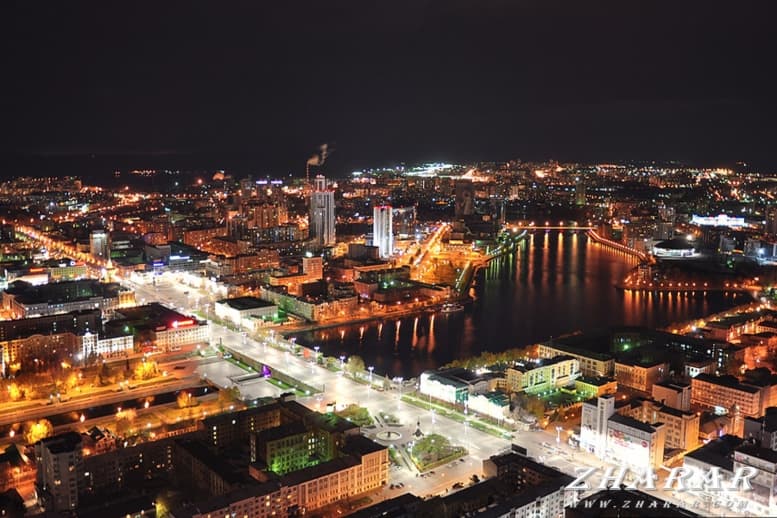
One of the largest, densely-populated and most interesting cities in Russia is Yekaterinburg. I’m lucky to have visited it myself as my uncle, who is my mother’s sibling, lives there. I should say I liked this city very much for its historic and architectural sights. All major attractions can be found in the central part. Perhaps, the best place for walks is the pedestrian zone known as Weiner Street. This street is full of stores, cafes, souvenir boutiques, outstanding monuments and spacious benches placed along the promenade. If you walk towards the 1905 Square you’ll reach Lenin Avenue. The same route leads to Plotinka on the bank of River Iset. The most picturesque and illuminated view here opens in the evening. My uncle says that one of the main pilgrimage routes runs here. The believers and many ordinary tourists visit the main cathedral of the city called Troitsky. Another popular religious destination is called Ganya’s Pit. If you want to enjoy the city view from the heights you should visit the 52nd floor of Vysotsky Center. I should mention that Yekaterinburg is perhaps one of the best cities for children, as it features a large zoo, waterpark, lots of carousels, outdoor exhibitions, theater performances, etc. Most of all I liked the park with gigantic Ferris wheel. Those interested in history would be surprised to know that this attractive city was named after Peter the Great’s wife — Catherine I.
Құрметті оқырман! Файлдарды күтпестен жүктеу үшін біздің сайтта тіркелуге кеңес береміз! Тіркелгеннен кейін сіз біздің сайттан файлдарды жүктеп қана қоймай, сайтқа ақпарат қоса аласыз! Сайтқа қосылыңыз, өкінбейсіз!
Тіркелу
Толық нұсқасын секундтан кейін жүктей аласыз!!!
Кейінірек оқу үшін сақтап қойыңыз:
| |
|
|
|
|
|
|
Қарап көріңіз 👇
Жаңалықтар:
» 2023 жылға арналған қасиетті күндер кестесі жарияланды 07.01.2023
» 2023 жылы Ораза қашан басталады ? 07.01.2023
» «Нағыз драма»: Аргентина араға 36 жыл салып әлем чемпионы атанды 19.12.2022
Басқа да бөлімдер:
Келесі мақала, жүктелуде…

